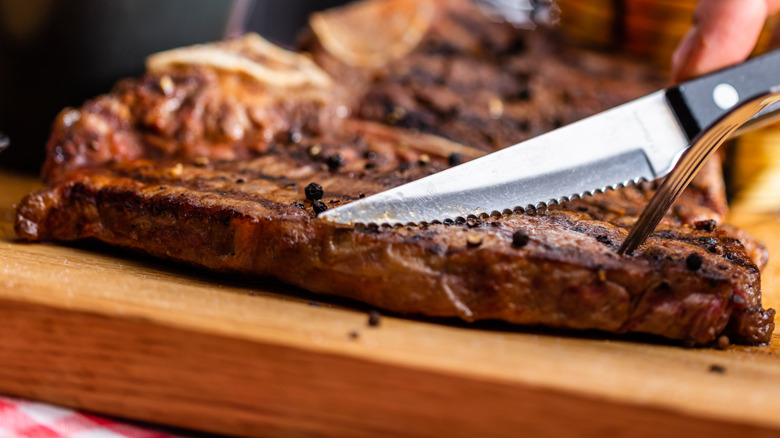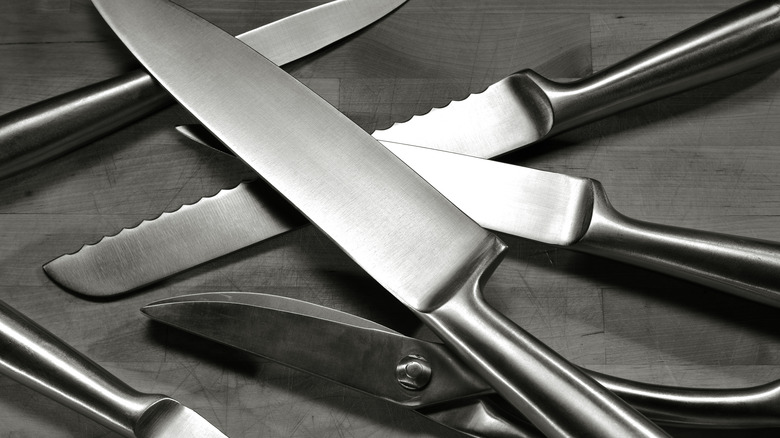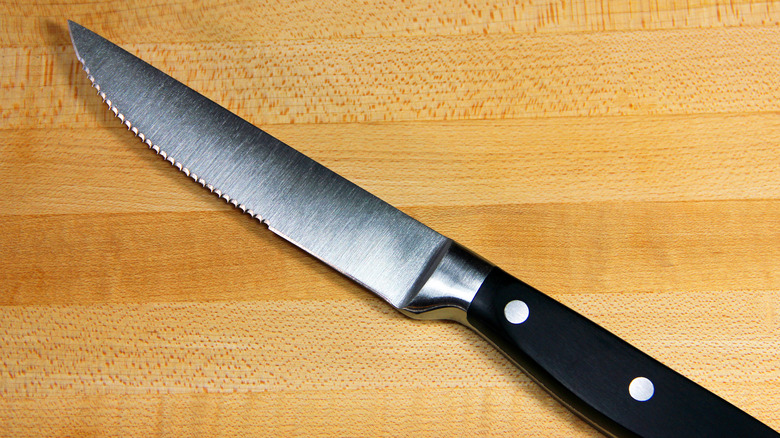The First Iteration Of The Steak Knife Had A Very Different Purpose
A good steak knife transforms your eating experience from a workout to a walk in the park. As the point precisely makes the first cut into your perfectly tender filet, the sharp blade cuts through the meat like it was a stick of butter. It seems like a perfectly conceived tool, but the steak knife actually originated in a realm outside of the kitchen. According to Popular Mechanics, the steak knife was born in the 1940s when businessman Charles D. Briddell Jr. received a letter opener as a gift. When his brother Tom saw the knife, it sparked an idea that would change the course of culinary history.
When Tom examined the letter opener, designed by a machinist named Paul C. Culver, he thought it would be the perfect tool for cutting meat. He quickly obtained a set of six knives from Culver and conducted a survey, which led him to believe that his hunch was correct — people loved them. The Briddell family was already in the business of manufacturing cutlery (Charles and Tom's father was a blacksmith who started his own company), so the stars aligned perfectly. They named their steak knife the Carvel Hall and started selling them in sets for $16.50. Before long the sets were on sale nationwide, and the steak knife was on its way to becoming an American institution.
The evolution of the steak knife
In 1953, The Salisbury Times ran a story about Paul C. Culver's letter opener being the basis for the first ever steak knife. By that point, Carvel Hall had transformed into a $3 million business, the newspaper said. However, the blade is only one part of what makes a good steak knife — they also need a good handle. That's where industrial designer Thomas Lamb comes in.
Lamb is the person who came up with the wedge-lock handle, a staple of modern knives. In 1954, he spoke to Industrial Design magazine for a piece entitled "Tom Lamb the Handle Man," in which he was incredibly humble about his work. According to Lamb, it all just came naturally to him. "Every time I design a handle, I go through the same door," he said. "How the door was found, I do not know." As the steak knife evolved, so did the accessories that came with them. After all, what good was having a fancy set of knives if you had nowhere to store or display them?
For years people were storing these sharp knives in ways that weren't particularly attractive or safe. However, that all changed in the 1970s when knife racks became all the rage. Writing for Home magazine (which came with the Los Angeles Times) in 1975, columnist Joan Dektar said: "Knives that have the quality of steel but can maintain a sharp edge are prized by most good cooks. And when they can be handsomely and conveniently displayed, they take on even more importance."
How to choose the right steak knife
While some people might want a knife that looks pretty when displayed, the look is not necessarily the primary concern when picking a great steak knife. Three areas are usually the focus: the blade, the material, and the handle. Usually, steak knives have either a straight edge or a serrated edge. While a serrated edge might require less pressure to cut steak quickly, the jagged edges make for a less clean cut. In addition, it is harder to sharpen a serrated edge (though not impossible). Therefore, a lot of people tend to choose a straight edge steak knife.
Second, the material is key for durability. Generally, stainless steel is a preferred choice for steak knives. In addition to its sturdiness, it does not rust as easily. Given all the use and washing, avoiding any rust is key for a great steak knife. Lastly, the handle is important not just for the design or style: A steak knife should not have any gaps between the knife and the handle. A seamless design makes for efficient use as well as impacting how it feels in the hand. It has to feel right — after all, no one wants to fumble with a sharp object. In the end, a great steak knife is a combination of form and function. Just make sure to hold the knife before letting an intricate design compel a purchase.


